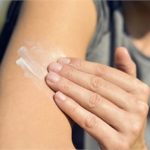
Solar purpura (SP) aka, senile purpura, actinic purpura are flat, purple marks that develop suddenly, typically on the hands and forearms of elderly people. While scary looking, they are nothing more than bruising due to thinning of the skin and fragility of blood vessels.
SP often develops with little or no known injury to the affected skin. The lesions may occur with open wounds that can be uncomfortable and may become infected requiring treatment with an antibiotic. Predisposing factors include sun exposure, prolonged use of topical steroid creams or oral steroids, and ingestion of blood thinning agents such as aspirin, clopidogrel (Plavix), warfarin (Coumadin), apixaban (Eliquis), and dabigatran etexilate (Pradaxa), NSAIDs, such as ibuprofen and naproxen, and certain supplements, such as fish oils.
Preventative measures include sun protection (broad spectrum sun screen with minimal SPF 30 and clothing), avoidance of trauma and unnecessary blood thinning agents. Men’s tube socks with the feet cut off at the ankle can provide a layer of protection when around the house. Proven treatment options don’t exist but topical agents containing arnica and bromelain might be of some benefit. The lesions generally take several weeks to spontaneously resolve but may leave a residual brown stain.


